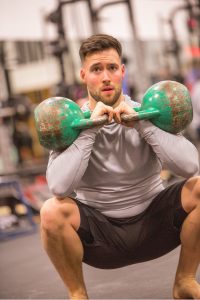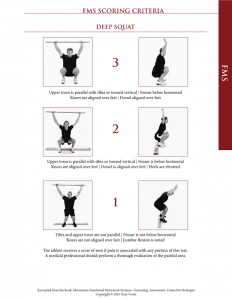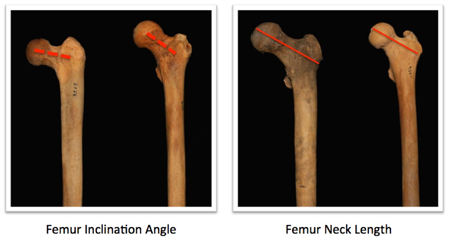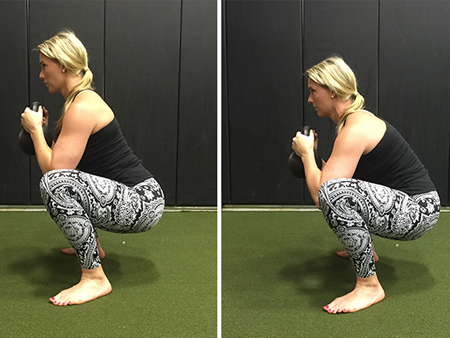Coaching And Progressing The Squat
“Squats can do more for total mass and body strength than probably all other lifts combined. Doing them wrong can do more damage than probably all the other moves, too. The goblet squat fixes all.” – Dan John
This coaching entanglement is something that we have faced up to and tackled willfully at Mike Boyle Strength & Conditioning (MBSC) when faced with the challenge of coaching a huge number of athletes.
 We’ve had to ask ourselves the following questions:
We’ve had to ask ourselves the following questions:
1). How do we assess if someone can squat?
2). How do we go about teaching and progressing the squat?
3). What is the terminal pattern for squatting? Do people need to squat heavy at all?
I hope this article can give you a full look into how we understand and program “The Squat” at MBSC.
The Squat: Movement versus Exercise
Squatting is certainly a functional movement for humans. Given our bipedal functionality it serves effective strategy to lower oneself closer to the ground, sit down, defecate and rest.
Purely as a movement it’s tough to define a “correct squat.” Whatever motor strategy is employed for us to lower ourselves through simultaneous knee and hip flexion to a complete the given task (play with small child, retrieve an object from a low cupboard or simply rest) would be deemed correct. It’s purely a motor strategy to complete a task. However, squatting for the purpose of strength development should be defined differently than squatting for the purpose of simplemovement.
Due to the inherent risks of squatting under load and to account for the most effective ways to produce force, there are certain form parameters and restrictions someone should adhere to if they intend on squatting in the weight room.
So how should we define what makes a “good squat” in the gym?
What Makes a Good Squat?
When it comes to defining and measuring what makes a good squat, I leave it to the FMS team to handle that. Gray Cook and Lee Burton have a system that works.
The Functional Movement Screen is an effective and reliable tool to help coaches assess the potential risk of training a movement with a client. With a brilliantly simple 3/2/1/0 scoring system, the coach can decide what movements are safe to train and what movements may need some work before adding load within only 10 minutes of assessment.
I won’t define all the FMS scoring criteria in this article but if you are interested in learning more about it (YOU SHOULD BE) you can follow this link: http://www.functionalmovement.com/
The scoring criteria for the squat is shown in the image below (click on the image to see the full FMS Scoring Criteria PDF):

(Cook, 2010)
At MBSC, we use the following procedure based on an individual’s FMS squat score.
- FMS Score: 3 = Train the movement starting at Goblet Squat.
- FMS Score: 2 = Train the movement but use caution. Check hip and ankle mobility and start with Squat Pressout or Heel Elevated Goblet Squat.
- FMS Score: 1 = Work on Mobility and Assisted Squat Pattern
- FMS Score: 0 = PAIN. Avoid squat pattern in training and refer out to a medical professional.
Coaching the Squat
Regardless of what squat progression you are training, your set up should be roughly the same. Where I believe many people go wrong is failing to understand what the right setup is for them.
One size does not fit all.
I get a lot of questions from both trainers and clients regarding squat setup and form. Here is the MBSC take on squat setup.
1. Where should my feet be?
The short answer: Shoulder-width apart.
Let the client find where they are comfortable. They may choose to squat a couple of inches narrower or wider than shoulder-width; as long as it is within reason, let them choose what is comfortable.
2. Toes straight or toes out?
The short answer: Toes slightly out.
Although we test the squat with toes strictly straight in the Functional Movement Screen that does not mean we must coach it like that during the exercise. The purpose of screening the movement like that is so that we have a strict standard of appraisal of which to judge the movement. The reason we allow external rotation of the hips during the exercise is because everyone’s hips are different and, quite frankly, you’ll be stronger that way.

We know that there is huge variation in femoral neck angle and pelvis shape amongst humans so it should it go without saying that we cannot expect them to squat exactly the same. Those who have a larger femoral neck angle will require more external rotation in the femur to sit into their squat.
How deep should I squat?
Short Answer: Femur parallel to the ground.
In a perfect world, I’d say everyone could squat “ass to grass” and many coaches hold that as their standard; however, if you coached a wide variety of people of people in your life you’ll find very plainly that it’s not a realistic or safe expectation. Acquired tightness, core weakness, and wide raging body anthropometrics can make squatting deep a nightmare for some clients. Forcing clients to actively bury their squats under load if they don’t have the hip mobility or core stability to get there is likely going to lead to injury.

In the image above, Molly Galbraith demonstrates a perfect squat pattern and in the image on the right, she demonstrates a poor squat pattern with pelvic and spinal flexion.
At MBSC we want all our clients to squat so that their femur is parallel to the ground or slightly below. For the average client, “getting to parallel” would mean squatting to a 12- or 14-inch box. It is not a box squat; it is a squat to a box. We don’t rest or rock off of it, we just tap it so that the client has a depth marker. You may need a slightly shorter or lower box depending on the client but the goal is for the client to maintain a neutral spine with a femur slightly below or a patparallel to the ground.
Knees over the toes or knees out?
Short Answer: Screw your feet in the ground.
I don’t advocate for saying knees out or knees over the toes because I think that it’s focusing on the wrong body part.
It’s all in the hips!
The knee is simply the linkage caught between the two anchors of the squat: The hips and the feet. This is where we should be focusing.
The “knees out” cue comes from coaching clients away from valgus position during squats. Although we don’t want our clients to be squatting in valgus, I think that flatly telling clients “knees out” places the emphasis in the wrong place. Focusing solely on the knees getting wide, often leads the client to overly supinate the foot while also placing high amounts of lateral stress at the knee.
I believe that a better strategy to cue hip external rotation is to ask them to “screw their feet into the ground.” I’ve found using this cue really gets the client to feel their feet and hips in the squat rather than emphasizing extreme varus at the knees.
How We Progress the Squat

1) Assisted Squat
The assisted squat is a great place to start for someone who’s never squatted, is coming off an injury or is simply too weak to do the exercise correctly. Here are two different variations of the assisted squat that we teach during the Certified Strength Coach Certification (CFSC).
TRX Assisted Squat
This is a great first progression because it provides the most support. Coach the client to have loose hands on the handles and only use as much support as they need. It should not appear like they are “waterskiing” from the TRX.
Cook Band Assisted Squat
The Cook Band provides assistance but doesn’t allow the athlete to hang off and use their upper body. The stretch of the band gives the most support at the bottom of the squat where it is needed most.
2) Squat Press Out
Once the client squats to parallel without assistance, the Squat Press Out can be used to begin building core stability in the squat pattern. I often use this as an introductory progression for clients who score a 2 on the FMS deep squat and as a warm-up drill for clients who will be squatting with load later on during the training session.
Cue them to reach the ball out slowly as they lower into the squat. The anterior reach will allow them to sit back into their hips and get their chest up tall while in the bottom of the squat.
3) Goblet Squat
Goblet Squat with Heels Elevated to High Box
We use this regression of the goblet squat for clients who cannot reach a 12-inch box without posterior tilting their pelvis or lack enough ankle mobility to keep their heels down.
Goblet Squat
This is the main squat progression we use for the majority of clients at MBSC. Our adult clients will train the goblet squat at a variety of different tempos and loads over the course of their programs.
4) Double Bell Front Squat
For clients that outgrow the goblet squat we progress to the Double Kettlebell front squat to progressively load the client
5A) Offset Kettlebell Front Squat
The offset squat can provide serve as a variable motor skill challenge for clients that may be looking for a challenge but are not suited for an increase in load.
5B) Front Squat
For athletes who are going to be Olympic lifting or those who are better suited for increased bilateral loading we use the front squat at our terminal bilateral squatting pattern.
The squat is a fundamental human movement that everyone should be able to do. However, not everyone has to load it the same. Having a solid, well thought progression that is adaptable to every client will allow you to get everyone squatting whether it be with a TRX or a Barbell.
EDITOR NOTE: The following article is re-post of an article that I wrote for PTOnTheNet.Com. To read the original article go here: http://www.ptonthenet.com/videos/progressing-and-regressing-the-squat
Enjoy!
-KC
References
John, D. T. (2011, March 3). Goblet Squats 101. Retrieved from https://www.t-nation.com/training/goblet-squats-101
FMS. (2017). Retrieved from http://www.functionalmovement.com/
Cook, G. (2010). PDF [FMS Scoring Criteria]. FMS. Retrieved from http://graycookmovement.com/downloads/FMS%20Scoring%20Criteria.pdf
– See more at: http://www.ptonthenet.com/articles/coaching-and-progressing-the-squat-4151#sthash.Sg3laZZO.dpuf